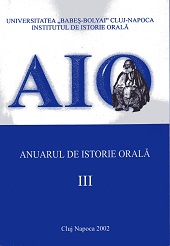Cum putem analiza fenomenul "Revoluţia românnă din decembire 1989"
How can We Analyze the December 1989's Romanian Revolution as a Social Phenomenon
Author(s): Sidonia Nedeianu GramaSubject(s): History
Published by: Argonaut
Summary/Abstract: This presentation proposes the opening of a workfield on 1989's Romanian Revolution in that will stand at the junction of certain social human branches of knowledge. This study has as a starting point our need to truly understand a major phenomenon that we witnessed and ... deeply changed our lives; the need we are talking about represents a condition to the human identity's development as well as to the health of the society we are living in. On the other side, scientifically speaking, such an attempt represents a real challenge to researchers. There are some theoretical and empirical directions outlined by the author for possible analysis; she puts forward some paradigms belonging to social sciences as oral history, cultural, anthropology, social psychology and mass communication sociology. By using these branches of knowledge, the 1989's Romanian Revolution complex phenomenon could be deeply explained and interpreted. Thus, epistemologically speaking, the above-mentioned events are disassembled and issued following these directions: 1. Being a recent historical event, the phenomenon fits to the oral history approach, implying a campaign to collect the participants' testimonies. 2. By considering the outlook of history and of the revolutions' sociology, diachronically and synchronically approaching them, the December events are situated within the context of the changes that occurred in Central and Eastern Europe. In these respects, the events in Romania differ because of their bloody violence and the hesitating rhythm of the society's reform. 3. Within the symbolic paradigm, the December revolution is considered a founding event that set up a new world; in this case the analysis' point would target the area of symbols and political myths, of the meanings and reasons that have been given to these witnessed events. 4. Being a media event, there should be analyzed the crucial role that mass media had during the events, especially of what we called the tele-revolution. 5. The Romanian revolution within collective memory offers us the opportunity to reflect upon the memory's wounds, uses and abuses, upon public attitudes towards the December events, and upon the need for justice. As a conclusion, this study is meant to be an invitation to a critical reflection and to a possible collaboration within a multidisciplinary research project focused on this theme.
Journal: Anuarul Institutului de Istorie Orală
- Issue Year: 2002
- Issue No: III
- Page Range: 20-39
- Page Count: 20
- Language: Romanian

